Celebrating 50 Years of Memories: Assateague State Park
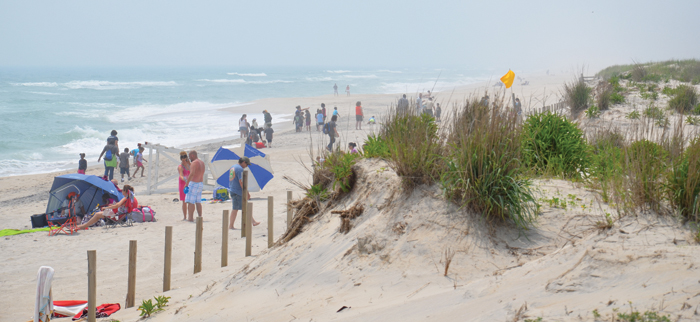
Modern-day Assateague; by Stephen Badger
Each year, more than one million visitors cross the Verrazano Bridge to the narrow strip of barrier island known as Assateague State Park.
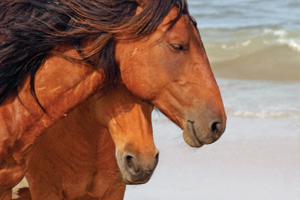
Ponies on the beach; by Sandra Sulivan
There they join a myriad of wildlife, including the island’s famous wild horses and elusive sika deer. Birds abound throughout the year in the marshes and on the beaches. Just offshore in the Atlantic Ocean swim dolphins, sea turtles, sharks and a whole host of other aquatic dwellers. The scenic Sinepuxent Bay provides habitat for diamondback terrapins, blue crabs, clams and mussels.
Nature thrives here, but it might not have been that way without the efforts of a determined group of citizens, a responsive government and a timely reminder from Mother Nature that such places can be very fragile and unstable.
Becoming a state park: an historical perspective
Assateague State Park was established following a long process that began in the 1930s, when the National Park Service recommended that barrier reefs and other coastal resources throughout the nation be protected for recreational use. In 1940, the Maryland State Planning Commission suggested establishing a state park on the island, emphasizing the importance of preserving the natural state of such sensitive areas.

Kids in a lifeguard chair in the 1970s; department photo
Meanwhile, development was creeping in. During the 1950s, the Ocean Beach Corporation sold hundreds of residential lots. Design plans called for commercial development and a causeway from the mainland, mirroring Ocean City.
But not everyone was happy to see development coming. Local citizens like Mr. William E. Green—known as Assateague’s unofficial senator—dedicated their energy to preserving the land for public use. Beginning in 1955 and every year thereafter until his death in the early 1960s, Green journeyed to Annapolis when the General Assembly convened and laid copies of a petition showing community support for preservation on every legislator’s desk.
Then came the Great March Storm of 1962, which destroyed 30 of houses already built on Assateague and damaged the remaining 18. The storm provided the final impetus behind state and federal efforts to make the island a publicly owned resource in its entirety. Assateague Island National Seashore was designated by Congress that year to protect the island in the states of Virginia and Maryland.
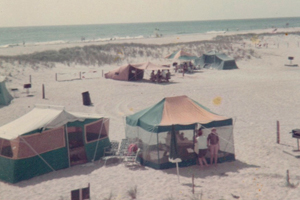
Families camping in the 1960s; department photo
Assateague State Park’s master development plan was completed in 1964. Later that year, the Maryland State Roads Commission completed the gateway to Assateague—the Verrazano Bridge. Construction of the park began soon thereafter, opening to the public in 1965. Over the next seven years, improvements were gradually added, including a bathhouse and concession building, a large parking area, campground loops and shower buildings.
Over time, more facilities were built to accommodate the park’s increasing popularity—additional campsites with a youth group camping area, modern restrooms, a nature center and permanent ranger station.
Then and Now
No one is better suited to talk about the early years than Carmella Baum, a visitor to Assateague who has been coming with her family every summer for the past 50 years. She recalled their first year camping when there were no paved parking areas or roads across the bridge, nor any buildings or facilities. Campers would set-up in a circle just behind the dune.
“The ranger would come around every evening and collect the $2 per night it cost for your campsite,” Baum remembers. She recalls the endless beaches, abundant bayberry and blackberry bushes where her five children would explore, and “the ponies that would come right up to you just like they do today.”
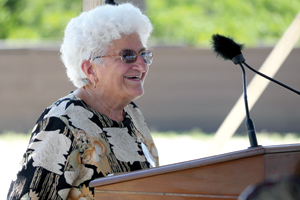
Carmella Baum
She talks about the original group of campers getting to know one another and becoming friends, returning year after year to spend their vacation time together. Many of their children, grandchildren and great-grandchildren still make Assateague State Park their annual family holiday.
Today, just like in 1965, families come to enjoy the tranquility, the ocean waves and the salt air; to make a connection to this place that holds so much beauty and diverse life. To think of how different the island would look had the development continued conjures up a completely different image of Assateague.
Whether you visited in 1965 or today, you can be comforted to know that it will be preserved as a park for the enjoyment of future generations and for the nature and wildlife that call it home for many years to come.
Anniversary Celebration
More than 400 visitors and guests attended the anniversary celebration this past August, which featured 1960s era arts and crafts, photo exhibits and displays of live birds and sea creatures.
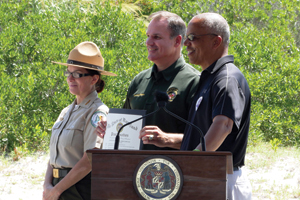
Superintendent Nita Settina, Sec. Mark Belton, Lt. Gov. Boyd Rutherford
A ceremony commemorated the park and recognized staff members and volunteers, past and present, as well as long-time visitors and campers.
Among the dignitaries in attendance, Lt. Governor Boyd Rutherford presented a Governor’s Proclamation recognizing August 14, 2015 as Assateague State Park Appreciation Day. The document urges all citizens to remember their own experiences on the island; create new memories with family and friends; share their love of this state treasure with those who have not yet enjoyed its grandeur; and join fellow Marylanders in saluting the park’s staff for their work in keeping Assateague State Park one of our premier destinations.
Article by Angela Baldwin—Assateague State Park manager.
Appears in Vol. 18, No. 4 of the Maryland Natural Resource magazine, fall 2015.


 1-888-373-7888
1-888-373-7888 233733
233733